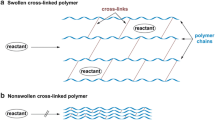Abstract
Late stage enzymatic prenylation and methylation are means to diversify (natural) compounds and to specify their functions. In eukaryotes and microbes, these steps are performed by large enzyme families, the prenyl and methyl transferases, which modify various types of small molecules, like isoprenoids, phenolics or alkaloids, but also DNA and proteins. We investigate the theoretical basis of these processes and possible commercial applications in synthetic chemistry.
Similar content being viewed by others
Literatur
Brandt W, Dessoy MA, Fulhorst M et al. (2004) A proposed mechanism for the reductive ring opening of the cyclodiphosphate MEcPP, a crucial transformation in the new DXP/MEP pathway to isoprenoids based on modeling studies and feeding experiments. Chembiochem 5:311–323
Wirsing L, Naumann K, Vogt T (2011) Arabidopsis methyltransferase fingerprints by affinity-based protein profiling. Anal Biochem 408:220–225
Zakharova S, Fulhorst M, Łuczak L et al. (2004) Synthesis, inhibitory and activation properties of prenyldiphosphate mimics for aromatic prenylations with ubiA-prenyl transferase. Arkivoc 13:79–96
Brandt W, Bräuer L, Günnewich N et al. (2009) Molecular and structural basis of metabolic diversity mediated by prenyldiphosphate converting enzymes. Phytochemistry 70:1758–1775
Wessjohann L, Sontag B (1996) Prenylation of benzoic acid derivatives catalyzed by a transferase from Escherichia coli overproduction: method development and substrate specificity. Angew Chem Int Ed Engl 35:1697–1699
Wessjohann L, Sontag B, Dessoy MA (1999) Enzymatic C-C-coupling: the development of aromatic prenylation for organic synthesis. In: Diedrichsen U, Lindhardt TK, Westermann B et al. (Hrsg) Bioorganic Chemistry — Highlights and New Aspects. Wiley-VCH, Weinheim. 79–88
Wessjohann L, Zakharova S, Schulze D et al. (2009) Enzymatic C-C-coupling prenylation: bioinformatics — modelling — mechanism — protein-redesign — biocatalytic application. Chimia 63:340–344
Galm U, Dessoy MA, Schmidt J et al. (2004) In vitro and in vivo production of new aminocoumarins by a combined biochemical, genetic, and synthetic approach. Chem Biol 11:173–183
Bräuer L, Brandt W, Schulze D (2008) A structural model of the membrane-bound aromatic prenyltransferase UbiA from E. coli. Chembiochem 9:982–992
Nickerson ML, Kostiha BN, Brandt W et al. (2010) UBIAD1 mutation alters a mitochondrial prenyltransferase to cause Schnyder corneal dystrophy. PloS One 5:e10760
Nakagawa K, Hirota Y, Sawada N et al. (2010) Identification of UBIAD1 as a novel human menaquinone-biosynthetic enzyme. Nature 468:117–121
Fredericks WJ, McGarvey T, Wang H et al. (2011) The bladder tumor suppressor protein TERE1 (UBIAD1) modulates cell cholesterol: implications for tumor progression. DNA Cell Biol 30:851–864
Pienkny S, Brandt W, Schmidt J et al. (2009) Functional characterization of a novel benzylisoquinoline O-methyltransferase suggests its involvement in papaverine biosynthesis in opium poppy (Papaver somniferum L). Plant J. 60:56–67
Author information
Authors and Affiliations
Corresponding author
Additional information
Ludger A. Wessjohann Chemiestudium. 1987–1990 Promotion, Universität Hamburg. 1990–1991 Postdoc, Stanford University, CA, USA. 1992–1998 Habilitation, LMU München. 1998–2000 Full Professor, Vrije Universität, Amsterdam, Niederlande. Seit 2000 Direktor der Abteilung Natur- und Wirkstoffchemie am Leibniz-Institut für Pflanzenbiochemie (IPB) und Lehrstuhl für Naturstoffchemie an der Universität Halle-Wittenberg. Seit 2010 Geschäftsführender Direktor des IPB.
Julia Kufka Jahrgang 1982. 2003–2007 Biologiestudium, TU Braunschweig. Seit 2007 Promotion am IPB, Abteilung Natur- und Wirkstoffchemie.
Thomas Vogt Biologiestudium. 1986–1989 Promotion, Universität zu Köln. 1990–1992 Postdoc, Universität von British Columbia, Vancouver, Kanada. 1992–1993 Postdoc, Washington State University, Pullman, WA, USA. Seit 1993 Gruppenleiter am IPB, Abteilung Stoffwechsel- und Zellbiologie. 2006 Habilitation in Biochemie an der Universität Halle-Wittenberg.
Robert Klein Jahrgang 1981. 2001–2007 Bioinformatikstudium, Universität Halle-Wittenberg. Seit 2008 Promotion am IPB, Abteilung Natur- und Wirkstoffchemie.
Rights and permissions
About this article
Cite this article
Wessjohann, L., Vogt, T., Kufka, J. et al. Prenyl- und Methyltransferasen in Natur und Synthese. Biospektrum 18, 22–25 (2012). https://doi.org/10.1007/s12268-012-0137-4
Published:
Issue Date:
DOI: https://doi.org/10.1007/s12268-012-0137-4




